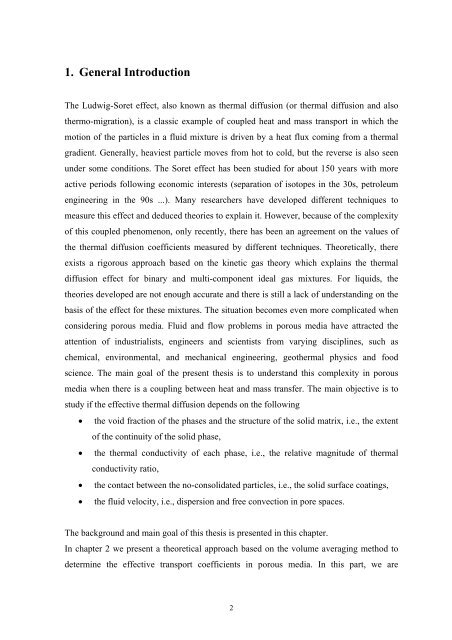r - Les thèses en ligne de l'INP - Institut National Polytechnique de ...
r - Les thèses en ligne de l'INP - Institut National Polytechnique de ...
r - Les thèses en ligne de l'INP - Institut National Polytechnique de ...
You also want an ePaper? Increase the reach of your titles
YUMPU automatically turns print PDFs into web optimized ePapers that Google loves.
1. G<strong>en</strong>eral Introduction<br />
The Ludwig-Soret effect, also known as thermal diffusion (or thermal diffusion and also<br />
thermo-migration), is a classic example of coupled heat and mass transport in which the<br />
motion of the particles in a fluid mixture is driv<strong>en</strong> by a heat flux coming from a thermal<br />
gradi<strong>en</strong>t. G<strong>en</strong>erally, heaviest particle moves from hot to cold, but the reverse is also se<strong>en</strong><br />
un<strong>de</strong>r some conditions. The Soret effect has be<strong>en</strong> studied for about 150 years with more<br />
active periods following economic interests (separation of isotopes in the 30s, petroleum<br />
<strong>en</strong>gineering in the 90s ...). Many researchers have <strong>de</strong>veloped differ<strong>en</strong>t techniques to<br />
measure this effect and <strong>de</strong>duced theories to explain it. However, because of the complexity<br />
of this coupled ph<strong>en</strong>om<strong>en</strong>on, only rec<strong>en</strong>tly, there has be<strong>en</strong> an agreem<strong>en</strong>t on the values of<br />
the thermal diffusion coeffici<strong>en</strong>ts measured by differ<strong>en</strong>t techniques. Theoretically, there<br />
exists a rigorous approach based on the kinetic gas theory which explains the thermal<br />
diffusion effect for binary and multi-compon<strong>en</strong>t i<strong>de</strong>al gas mixtures. For liquids, the<br />
theories <strong>de</strong>veloped are not <strong>en</strong>ough accurate and there is still a lack of un<strong>de</strong>rstanding on the<br />
basis of the effect for these mixtures. The situation becomes ev<strong>en</strong> more complicated wh<strong>en</strong><br />
consi<strong>de</strong>ring porous media. Fluid and flow problems in porous media have attracted the<br />
att<strong>en</strong>tion of industrialists, <strong>en</strong>gineers and sci<strong>en</strong>tists from varying disciplines, such as<br />
chemical, <strong>en</strong>vironm<strong>en</strong>tal, and mechanical <strong>en</strong>gineering, geothermal physics and food<br />
sci<strong>en</strong>ce. The main goal of the pres<strong>en</strong>t thesis is to un<strong>de</strong>rstand this complexity in porous<br />
media wh<strong>en</strong> there is a coupling betwe<strong>en</strong> heat and mass transfer. The main objective is to<br />
study if the effective thermal diffusion <strong>de</strong>p<strong>en</strong>ds on the following<br />
• the void fraction of the phases and the structure of the solid matrix, i.e., the ext<strong>en</strong>t<br />
of the continuity of the solid phase,<br />
• the thermal conductivity of each phase, i.e., the relative magnitu<strong>de</strong> of thermal<br />
conductivity ratio,<br />
• the contact betwe<strong>en</strong> the no-consolidated particles, i.e., the solid surface coatings,<br />
• the fluid velocity, i.e., dispersion and free convection in pore spaces.<br />
The background and main goal of this thesis is pres<strong>en</strong>ted in this chapter.<br />
In chapter 2 we pres<strong>en</strong>t a theoretical approach based on the volume averaging method to<br />
<strong>de</strong>termine the effective transport coeffici<strong>en</strong>ts in porous media. In this part, we are<br />
2

















